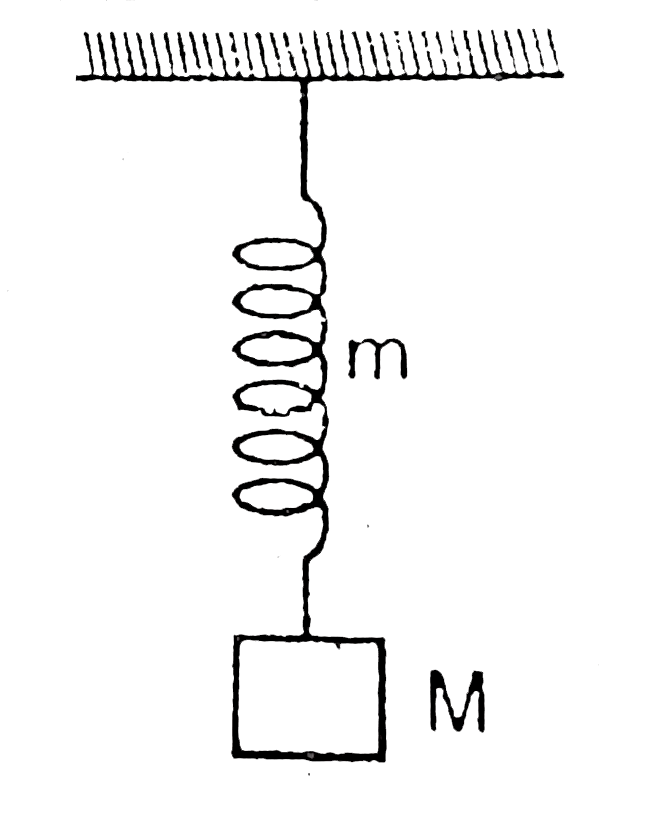A mass M is suspended from a massless spring. An additional mass m stretches the spring further by a distance x. The combined mass will oscillate with a period
2π ⎷{(M+m)xmg}
2π ⎷{mg(M+m)x}
π2 ⎷{mg(M+m)x}
2π ⎷{(M+m)mgx}
The correct Answer is:A
To solve the problem, we need to determine the period of oscillation of a mass-spring system where a mass M is suspended from a massless spring and an additional mass m stretches the spring further by a distance x.
1. Understanding the System:
- A mass M is hanging from a spring, and when an additional mass m is added, it stretches the spring by a distance x.
- The system reaches a new equilibrium position due to the additional mass.
2. Applying Hooke's Law:
- The force exerted by the spring when it is stretched by distance x is given by Hooke's Law:
Fspring=kx
- Here, k is the spring constant.
3. Balancing Forces:
- At equilibrium, the gravitational force acting on the additional mass m is balanced by the spring force:
mg=kx
- Rearranging this gives us the spring constant k:
k=mgx
4. Finding the Total Mass:
- The total mass that will oscillate is the sum of the two masses:
Mtotal=M+m
5. Using the Formula for Period of Oscillation:
- The period T of a mass-spring system is given by:
T=2π√Mtotalk
- Substituting Mtotal=M+m and k=mgx into the formula:
T=2π√M+mmgx
6. Simplifying the Expression:
- This simplifies to:
T=2π√(M+m)xmg
7. Final Result:
- Therefore, the period of oscillation of the combined mass-spring system is:
T=2π√(M+m)xmg
Conclusion:
The correct expression for the period of oscillation is T=2π√(M+m)xmg.
- A mass M is hanging from a spring, and when an additional mass m is added, it stretches the spring by a distance x.
- The system reaches a new equilibrium position due to the additional mass.
- The force exerted by the spring when it is stretched by distance x is given by Hooke's Law:
Fspring=kx
- Here, k is the spring constant.
- At equilibrium, the gravitational force acting on the additional mass m is balanced by the spring force:
mg=kx
- Rearranging this gives us the spring constant k:
k=mgx
- The total mass that will oscillate is the sum of the two masses:
Mtotal=M+m
- The period T of a mass-spring system is given by:
T=2π√Mtotalk
- Substituting Mtotal=M+m and k=mgx into the formula:
T=2π√M+mmgx
- This simplifies to:
T=2π√(M+m)xmg
- Therefore, the period of oscillation of the combined mass-spring system is:
T=2π√(M+m)xmg
The correct expression for the period of oscillation is T=2π√(M+m)xmg.
Similar Questions
A mass M is suspended from a light spring. An additional mass m added to it displaces the spring further by distance x then its time period is
View SolutionA block with a mass of 3.00kg is suspended from an ideal spring having negligible mass and stretches the spring by 0.2m.
(a) What is the force constant of the spring?
(b) What is the period of oscillation of the block if it is pulled down and released ?View SolutionA block with a mass of 3.00kg is suspended from an ideal spring having negligible mass and stretches the spring by 0.2m.
(a) What is the force constant of the spring?
(b) What is the period of oscillation of the block if it is pulled down and released ?View SolutionA mass M is suspended from a spring of negiliglible mass the spring is pulled a little and then released so that the mass executes simple harmonic oscillation with a time period T If the mass is increases by m the time period because (54T),The ratio of mM is
View Solution
A block of M is suspended from a vertical spring of mass m as shown in the figure. When block is pulled down and released the mass oscillates with maximum velocity v.View SolutionMass suspended to a spring is pulled down by 2.5 cm and let go. The mass oscillates with an amplitude of
View SolutionA mass M is suspended from a spring of negligible mass. The spring is pulled a little then released, so that the mass executes simple harmonic motion of time period T. If the mass is increased by m, the time period becomes 5T3. Find the ratio of m/M.
View SolutionA mass is suspended from a vertica spring which is executing SHM of frequency 5 Hz.
The spring is unstretched at the highest point of oscillation. Maximum speed of the mass is (take, acceleration due to gravity, g=10m/s2 )View SolutionOne mass m is suspended from a spring. Time period of oscilation is T. now if spring is divided into n pieces & these are joined in parallel order then time period of oscillation if same mass is suspended.
View SolutionLet T1andT2 be the periods of springs A and B when mass M is suspended from one end of each spring. If both springs are taken in series and the same mass M is, suspended from the séries combination, the time period is T, then
View Solution

